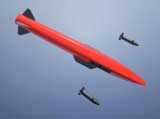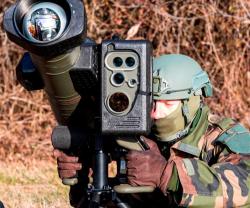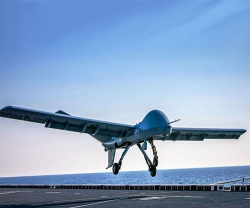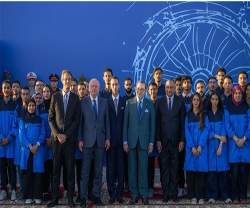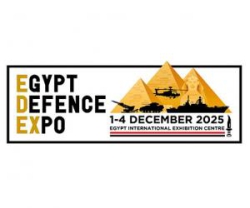MBDA Reveals Perseus Concept Missile System
23.06.2011 Security
MBDA unveiled the output of the Concept Visions process for 2011; CVS 401 Perseus concept missile system, which represents the group’s vision of a multi-role strike weapon system for 2030 and beyond.
To replace the current generation of heavy anti-ship and cruise missiles, a new system will be required that is capable of launching anti-ship strikes, land attacks and engaging time-sensitive targets such as relocatable missile launchers in an ever more complex tactical environment and with the minimum risk of collateral damage. This new system will also have to be modular and deliverable from a maritime environment, namely from a surface vessel, a submarine, a carrier-based platform or a maritime patrol aircraft.
Perseus features multiple operating modes against a wide land and maritime target set with the added capability of being able to overcome the most effective of enemy missile defences. It is designed to be a tactical weapon system operated through an advanced Operations & Mission Planning System at the crossroads of naval, land and air warfare. The advanced supersonic (up to Mach 3), agile and stealthy airframe is powered by a revolutionary ramjet motor built around a highly compact Continuous Detonation Wave Engine. This revolutionary solution, at the very edge of propulsion technology, opens up the possibility of developing a smaller airframe with more energetic efficiency. This airframe will make Perseus an unrivalled penetrator of enemy defences and an effective weapon for use against fast moving, relocatable targets that it will be able to reach in a matter of minutes even at ranges of up to 300 km.
An advanced dual-mode sensor package comprising an Active Electronically-Scanned Array (AESA) radar combined with a laser radar or LADAR) allows for all-weather operations in all configurations of terminal engagement. Radar modes such as SAR (Synthetic Aperture Radar) and DBS (Doppler Beam Sharpening) allow for long range target detection and discrimination in complex land and naval tactical environments.
Overall weapon system robustness is reinforced by an advanced, hybridised navigation system. The lethal package includes 2 guided effectors that are ejected from the modular payload bay and a third warhead remaining on-board for a dispersed lethal effect on large or multi-element targets such as a major warship or a ground based missile system. Moreover, the missile’s new modular composite structure allows for reductions in the overall mass of the weapon and fosters opportunities for through-life capability enhancement, simplifying maintenance operations through the whole life cycle and the eventual development of a family of products.
Perseus features a highly original shape providing to optimise key performance characteristics and adaptability for integration on a range of naval and air platforms. The weapon’s general performance with regard to its flight characteristics, its manoeuvrability, its propulsion as well as the detection capabilities of its sensors and the efficiency of its multiple military warhead have all been evaluated through digital simulations. As Perseus will be a tactical missile, the question of its operational deployment and access to tactical theatre data has also been considered so that a coherent and efficient weapon system architecture can be proposed.
A team of nine British, French, German and Italian engineers from MBDA, together with representatives from the Royal Navy and the French Navy, has evaluated the requirement and the solution for Perseus from operational analysis through to key performance specifications. The project has also benefited from the innovative mindset that exists within MBDA and which is fostered by the group’s Innovation Challenge initiative that was also called on to contribute ideas.
To replace the current generation of heavy anti-ship and cruise missiles, a new system will be required that is capable of launching anti-ship strikes, land attacks and engaging time-sensitive targets such as relocatable missile launchers in an ever more complex tactical environment and with the minimum risk of collateral damage. This new system will also have to be modular and deliverable from a maritime environment, namely from a surface vessel, a submarine, a carrier-based platform or a maritime patrol aircraft.
Perseus features multiple operating modes against a wide land and maritime target set with the added capability of being able to overcome the most effective of enemy missile defences. It is designed to be a tactical weapon system operated through an advanced Operations & Mission Planning System at the crossroads of naval, land and air warfare. The advanced supersonic (up to Mach 3), agile and stealthy airframe is powered by a revolutionary ramjet motor built around a highly compact Continuous Detonation Wave Engine. This revolutionary solution, at the very edge of propulsion technology, opens up the possibility of developing a smaller airframe with more energetic efficiency. This airframe will make Perseus an unrivalled penetrator of enemy defences and an effective weapon for use against fast moving, relocatable targets that it will be able to reach in a matter of minutes even at ranges of up to 300 km.
An advanced dual-mode sensor package comprising an Active Electronically-Scanned Array (AESA) radar combined with a laser radar or LADAR) allows for all-weather operations in all configurations of terminal engagement. Radar modes such as SAR (Synthetic Aperture Radar) and DBS (Doppler Beam Sharpening) allow for long range target detection and discrimination in complex land and naval tactical environments.
Overall weapon system robustness is reinforced by an advanced, hybridised navigation system. The lethal package includes 2 guided effectors that are ejected from the modular payload bay and a third warhead remaining on-board for a dispersed lethal effect on large or multi-element targets such as a major warship or a ground based missile system. Moreover, the missile’s new modular composite structure allows for reductions in the overall mass of the weapon and fosters opportunities for through-life capability enhancement, simplifying maintenance operations through the whole life cycle and the eventual development of a family of products.
Perseus features a highly original shape providing to optimise key performance characteristics and adaptability for integration on a range of naval and air platforms. The weapon’s general performance with regard to its flight characteristics, its manoeuvrability, its propulsion as well as the detection capabilities of its sensors and the efficiency of its multiple military warhead have all been evaluated through digital simulations. As Perseus will be a tactical missile, the question of its operational deployment and access to tactical theatre data has also been considered so that a coherent and efficient weapon system architecture can be proposed.
A team of nine British, French, German and Italian engineers from MBDA, together with representatives from the Royal Navy and the French Navy, has evaluated the requirement and the solution for Perseus from operational analysis through to key performance specifications. The project has also benefited from the innovative mindset that exists within MBDA and which is fostered by the group’s Innovation Challenge initiative that was also called on to contribute ideas.
Previous PostGCC Forces in Joint Military Exercise
Latest news
Latest events
Dubai International Air Chiefs’ Conference (DIACC 2025)
16 Nov 2025Atlantis, The Palm Dubai - United Arab EmiratesDubai Airshow
17 - 21 Nov 2025Dubai World Central (DWC) - United Arab EmiratesEgypt Defence Expo (EDEX)
01 - 04 Dec 2025Egypt International Exhibition Center New Cairo - EgyptDoha International Maritime Defence Exhibition & Conference (DIMDEX 2026)
19 - 22 Jan 2026Doha - Qatar

